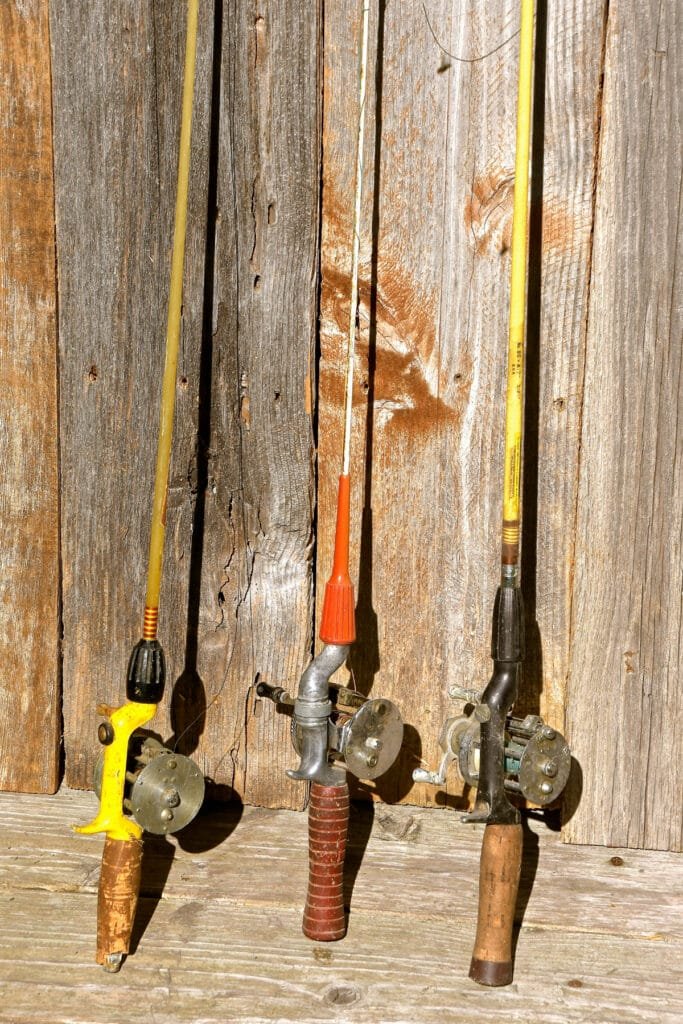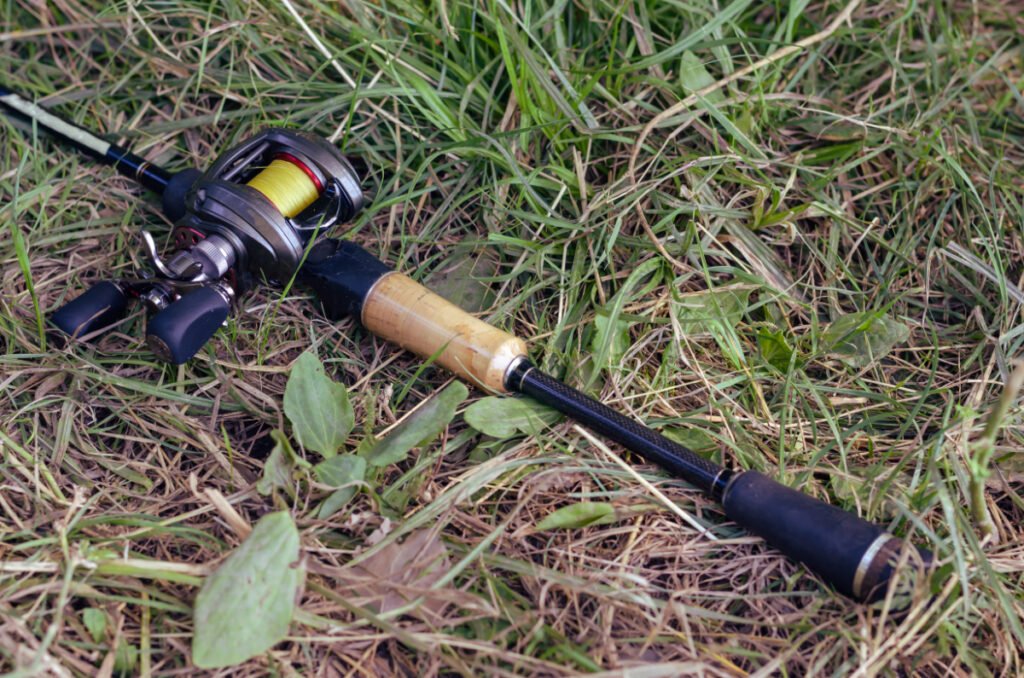If you are a sports freak, you must have tried fishing! After all, it’s the only sport that gets you money on a catch. But do you know that you can earn millions for the old thin fishing tool, too? Well, if you have any antique fishing rods in your shed, it’s time for resale!
But yes! You won’t get money just because your fishing rod is old and handmade. There have to be some special features that make it unique and truly vintage. Today, I’ll explain all these features and more in this antique fishing rod identification guide.
Key Takeaways
- Antique fishing rods with hand-cut grooves and tempers are the most precious ones! So check your rod for lacquers or wax polishes.
- Get fishing rods with bone, clay, wood, or hide handles for an old make. Similarly, look for split screw or stapled joineries!
- Pick rare or branded fishing rods with gold or silver carvings for high returns.
- You can get three types of fishing rods – spinning, ice, or surf fishing. Of these, the deep sea spinning or surf fishing rods give the best returns.
Identification Features of Old Antique Fishing Rods

Take your fishing rod and hold it parallel to the ground, at arm’s length. If it stands straight, it’s old and antique, costing $500 – 600. But if it sags and bends, it might be new and cheap, costing $20 – 30. Next, look for split wood screws and pegs!
But if you don’t see them clearly look for the following features:
- Equal wood sections with no bumps and machine varnish
- Metal/sheet tempered tips, grooved rings, and bulged grips
- Shiny lacquer, rope guides, and grooved handles
- A 6 – 8 feet tall with a 2-feet grip and equal rings
How Did Antique Fishing Rods Evolve?
Have you ever seen the old Stone Age-era tools in museums? You always get them in wood, bone, and stone. Well, it’s the same with antique fishing rods! In fact, you’ll see crude shellac and bamboo weaves with the ancient 1700s models, which are highly precious!
Woodworking tools like the crosscut and handsaw entered the market in the 1800s. Makers used them to shape hazel or oak branches for thick and light fishing rods. But they were really inflexible and broke easily, so their demand went down!
The 1900s were more of machines. So, you can see machine-shaped steel, iron, or zinc rods in this era. These are pretty light and portable, but you can also get them easily! So, they are really cheap, and you can price one up to $40.
3 Types of Antique Fishing Rods & Their Value
Did you know that in ancient times, people used different rods for river and sea fishing? Yes, and each type had different parts and features that now impact the cost. Let’s see how!
1. Spinning Fishing Rod

Spinning rods are long, ductile fishing tools to catch deep, saltwater fish. So, they are more flexible and have less friction than others. You’ll also see 5 – 8 steel guides and rounded tips with them.
And, if you want to know if your spinning rod is old, check its reel. If it sits below the central rod, your piece costs $100 – 150. If not, $50 – 60 is good!
2. Ice Fishing Rods

You might have seen the short, curved fishing rods with Disney toons! Ice rods look the same but have solid wood handles and guides. You can even see some rope guides, opposing hooks, and short, 10-inch grips with them. So, they are cheaper, at $40 – 50.
3. Surf Fishing Rods
If you see an oversized fishing rod with 10 – 14 feet long handles, it’s a surf fishing rod. Made with coated metal or wood, these rods weigh about 6 -7 lbs, perfect for catching fish in the rough seas. Plus, most have durable lead grips and baits, costing $100 – 200.
6 Factors to Spot & Value a Vintage Fishing Rod
Generally, old fishing rods are worth only around $5 to $50, but rare & antique fishing rod models can be valued at around $1,000 or even more. As you saw above, the value of an old fishing rod changes with types, but there are some other crucial factors you must consider!
1. Manufacturing Date & Age

It’s pretty obvious that old bone or bamboo fishing rods are the most precious. But today, you can find them only in museums and galleries. So, if you want a rod for your collection, get the wooden 1800s ones. And if you want them in steel, the 1900s models are perfect!
But what if you get a composite fishing rod? Yes, it’s quite possible. So, here’s how to track the age of those:
How Does a 1700s Fishing Rod Look?
Most of the 1700s fishing rods were handmade. So, they were really heavy and had local bone and hide handles. They were also short, 2-3 feet long, and bent in the rough seas. Also, look for tied rope guides and stone reels! If you see them, your rod costs $300 – 400.
How Do You Know If Your Fishing Rod Is from the 1800s?
Look for seasoned or lacquered wood fishing rods to spot these! You’ll also find some mechanical tools like spinning reels, locks, and keepers with them. Most will also have bark strips, iron or copper guides. So, you can price your piece for $150 – 250 as per the material!
How Do You Check a 1900s Fishing Rod?
Check if your fishing rod has thin steel sections, rollers, and wire guides. If yes, it’s a 1900s rod! You can also check for logos, patents, or brands on its handle. And, if you see split cane handles and reels, price the piece at $100. Otherwise, $70 – 80 is okay!
Here are some fishing rod patent numbers for help:
| Year | Age | Patent Number | Average Valuation |
| 1887 | 136 years | US359153A | $150 – 200 |
| 1988 | 35 years | 4874140 | $60 – 80 |
| 1980 | 43 years | 4899953 | $90 – 100 |
Get rods with traditional silver, graphite, or silver fittings for an old make.
2. Handle Materials

Get a tape and measure the handles’ thickness. If it’s 16 – 20” in diameter, you might have stone, bone, or clay handles. And you can price such pieces for $200 – 300.
But, if it’s less than that, you might have a wood or metal fishing rod. So, strike it with an old hammer, and check the ringing sound. If the handle rings, it might be steel or fiberglass, costing $10 – 20. But, if it dampens the sound, it might be a wood rod, valuing $50 – 60.
Want to know more details about each material? Here’s a list:
| Old Fishing Rod Handle Materials | Average Valuation |
| Sliced Stone, Bone, Hide | $100 – 120 |
| Clay, Ceramics | $80 – 90 |
| Bamboo, Weaved Grass | $70 – 80 |
| Wood – Hickory, Juniper, Snakewood or Medlar | $50 – 60 |
| Cast & Alloyed Steel | $30 – 40 |
| Zinc & Stainless Steel | $10 – 15 |
| Plastic & Fiberglass | $2 – 5 |
Pick fishing rods with split screw-style reel seats and stapled joineries for the best returns.
3. Guide Materials

Now, you might think fishing rod guides come only in wood and metal! Yes, they are definitely a sub-type. But antique fishing rods have so many guide materials – clay, thread, and bamboo! So, you can get these natural guides if you want a handmade finish.
But, if you want more usability, go for the new wood or metal ones. It’s just that they are machine-made and cheaper.
Here’s a table to give you an idea of each guide material’s value:
| Old Fishing Rod Guide Materials | Average Valuation |
| Clay, Ceramics & Thread | $80 – 90 |
| Bamboo & Willow | $50 – 80 |
| Wood Bark – Hickory, Red Oak, Beech | $30 – 50 |
| Ductile Iron / Steel | $15 – 20 |
| Fiberglass, Stainless Steel or Titanium | $8 – 10 |
Pick guides with a brown, gray, orange, or reddish stain for high returns.
4. Antique Fishing Rod Brands

Tired of checking the fishing rod’s age and material? Well, just rotate the handle and see if you get any logos, brand names, or signs to confirm the brand and price your piece! You can also look for gold or silver carvings to hike the costs!
Here are some famous brands and their values for reference:
| Old Fishing Rod Name | Manufacturer | Antique Fishing Rod Type | Average Valuation |
| MELO6 | Lyle Dickerson | Bamboo Fishing Rod | $3500 |
| Pinky Rod | H.S Gillium | Spinning Fishing Rod | $200 – 250 |
| Contact 2 Fly Rod | Thomas & Thomas | Aluminium Fishing Rod | $800 – 900 |
| 4 / 5 | Marty Karstetter | Bamboo Fishing Rod | $1200 – 1500 |
Pick fishing rods with etched or embossed signs as painted ones might be fake and cheap.
5. Rare Antique Fishing Rods
Rare, difficult-to-get models obviously fetch a high value at any auction! So, if your fishing rod comes from a premium collection, you can raise its cost by 20 – 25%.
Similarly, if it’s of royal or historical origins, it costs $1000 – 1200. And if it’s a limited-edition hunting rod, its value goes up to $3000.
Here are some rare fishing rods for your collection:
| Rare Fishing Rod’s Name | Year | Valuation |
| Paul H. Young Short Taper Fishing Rod | 1949 | $5,500 – 6,000 |
| G.H Howells Bamboo Fly Rod | 1900s | $5,400 |
| H.L Leonard Fly Rod | 1980s | $5,000 |
| Wright & McGill Granger Bamboo Fly Rod | 1937 | $1,000 – 1,200 |
| Ed Fody Bamboo Fly Rod | 1990s | $1,500 – 2,000 |
Check if your fishing rod has a 5:5 or 6:4 bending ratio to spot the rare ones.
6. Condition
If you want thick, high-demand fishing rods, ensure they don’t have any chips or cracks! That’s because if your fishing rod has any flaws or faded parts, it loses its value by 10 – 12%. Similarly, you won’t get more than $100 if your rod has caught mold or rust!
Rinse your fishing rods with anti-rust solutions or white vinegar to get rid of the mold.
Does the Color of an Antique Fishing Rod Matter?
No, you can get fishing rods in bare wood or metal finishes for good value. But, it’s better to avoid the painted or polished ones as those might be new and cheaper.
How Do You Clean Antique Fishing Rods?
Soak your fishing rods in lukewarm water and dab them lightly to remove the mold and fungus. You can also scrub them with non-abrasive dish soaps and baking soda to restore the shine.
Obviously, you won’t get good returns for any fishing rod! For that, you must check your rod’s age, handles, and condition! Also, look for any logos or brand marks to hike the cost! And thankfully, we have covered everything above. So just check the details and add the costs!
Just like fishing rods, old fishing lures made of unique materials are highly collectible today. Want to learn how to spot these hidden gems? I have explained all the details in my guide on vintage fishing lures!
Note: This article is intended for informational, educational, and entertainment purposes only. Some images are illustrative and may not represent actual brands, products, or related entities. All trademarks, product names, brand logos, packaging, and other intellectual property referenced remain the exclusive property of their respective owners. Any brand mentions or references are provided solely for descriptive and educational context and do not imply any formal or commercial association.










